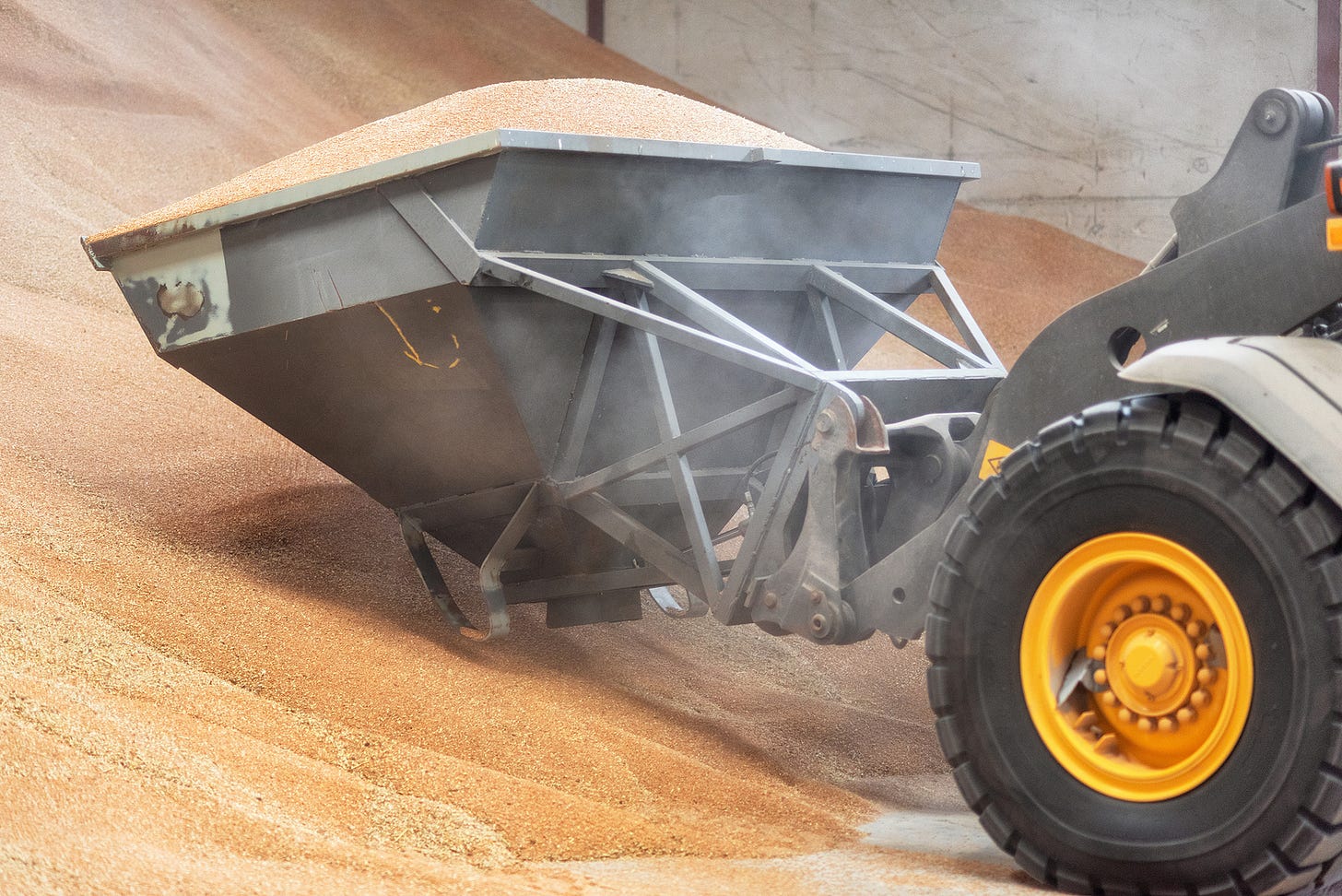AI for food fraud protection - a webinar;
Food Safety Treasure Hunt: Answers and Winners;
From the archives.
Hi!
Welcome to Issue 185 of The Rotten Apple. Today is a holiday in many countries, including mine, so I am departing from our usual format this week.
Instead of the usual four sections, I’m sharing the answers to our food safety treasure hunt, including links to sources and stories of past food safety incidents as supporting evidence.
And I announce the winners, of course! I’ve also dug up some popular past posts from the archives in case you missed them: a case study about organic fraud, a short piece about laboratory fraud and a deep dive into a deadly pathogen.
There’s no food safety or food fraud news this week, but don’t despair. We’ll catch up on the food fraud news next week (for paying subscribers), so you don’t miss a thing. Because being a paid subscriber means getting access to high-quality food fraud updates…. and supporting my mission to help you stay up to date without the boring bits.
Thank you!
Karen
P.S. Need more info about paid subscriptions? Learn more here. Or….
Save The Date | Webinar 15th May
Our next live event, on Thursday 15th May, features AI expert Asli Solmaz-Kaiser, who will show us how AI can be used with big data to protect our businesses from food fraud.
Click the preview below for all the details.
AI for Food Fraud Detection, Horizon Scanning and Vulnerability Assessments - Webinar
Come and join our next live training event, a webinar about AI for food fraud controls.
Food Safety Treasure Hunt | Answers and Winners

Correct answer
The treasure hunt led you to all six locations:
Restaurant | lettuce farm | sausage-maker | chocolate factory | delicatessen | market
The treasure
The treasure was at the fresh food market.
The treasure you found is safe food for all, From farm to factory, big or small. This hunt ended with my fervent wish: Safer food in every dish.
The winners
Three winners have been chosen from the first ten correct entries and will receive a food safety champion mug.
The winners are: Helena from Croatia, Panagiotis from a patisserie chain in Greece and Leigh from an avaition snack manufacturer in England1.
Congratulations to everyone who entered, overall 86% of you found the treasure!
The clues explained…
First clue
Allergen controls are important at all food sites, but allergen awareness in front-line staff is critical to protect customers at this type of place. Allergen-related failures by the supplier of a facility like this were the root cause of a death we examined in Issue 123.
When you get to the site, check that cook temperatures are sufficient for pathogen inactivation.
Answer:
The correct answer is restaurant. Front line staff in a restaurant are critical for allergen control, because they provide information about the presence of allergens in the food for allergenic customers. Cook temperatures are a secondary clue, with most of the other sites around the town unlikely to be cooking food for pathogen inactivation.
Second clue
In water that flows or stands still, Pathogens can lurk and can kill. Test water with care, Keep it clean and fair— Safe salads depend on your skill.
When you arrive there, check that there are systems to keep wild animals and birds from coming into contact with the food.
Answer:
The correct answer is lettuce farm. Water, including wash water and irrigation water, can carry bacterial pathogens like Shiga-toxin producing E. coli (STEC).
Learn more: Lessons Learned from a Decade of Investigations of Shiga Toxin–Producing Escherichia coli Outbreaks Linked to Leafy Greens, United States and Canada | Emerging Infectious Diseases
Third clue
Go to the place where you can expect to find sodium nitrate, an additive used to prevent the growth of Clostridium botulinum in certain types of food.
Answer:
The correct answer is butcher/sausage-maker’s shop. Sodium nitrate is added to fermented sausages like salami and Kransky to prevent the growth of Clostridium botulinum.
None of the other food sites in town would be using sodium nitrate as an ingredient. Although the delicatessen might sell food with added sodium nitrate, they are unlikely to have the chemical on site.
Fourth clue
Salmonella has a hidden quirk,
In dry foods it can stay and lurk.
High-fat foods, with moisture low,
Can harbour it for a year or so.
Through lecithin, it gets inside
Our Easter foods, where it can abide.
Recalls a-plenty in 2022,
Proof that suppliers are risky too. Answer:
The correct answer is chocolate factory. High-fat, low-moisture foods, including chocolate and peanut butter, allow Salmonella to survive for up to one year (source). A second hint is Easter foods, of which chocolate eggs are a famous example.
In 2022, there was a large recall of Ferrero Easter eggs for Salmonella which was later traced to the filter in a tank of dairy butter. In the same year, a massive recall by chocolate maker Barry Callebaut was attributed to the lecithin emulsifier used in the chocolate. Read more and get sources in Issue 45.
Fifth clue
Skilled food safety inspectors will pay close attention to a certain piece of machinery or appliance when they visit a site like this.
The machine must be completely dismantled, scrubbed clean and sanitised daily to prevent the build-up of biofilms of Listeria and Salmonella. This type of machinery is thought to have been a contributing factor in the recent Boar’s Head outbreak, as it may have transferred pathogens from contaminated liverwurst to non-contaminated foods. It was also instrumental in the famous Maple Leaf Foods listeriosis outbreak of 2008.
Go to the place that has that piece of machinery and also has bread. When you get there, look for a clue near the bread.
The correct answer is delicatessen. Deli slicers are notoriously difficult to clean and can harbour pathogens including Listeria and Salmonella. Deli slicers are suspected of transferring Listeria monocytogenes from contaminated Boar’s Head liverwurst to other deli meats during the 2024 outbreak.
Maple Leaf Foods’ listeriosis outbreak in 2008 killed 23 people, making it the deadliest single-source foodborne outbreak in Canada's recent history. Slicers were the source of the contamination, with bacteria accumulating in hard-to-clean machinery components despite daily cleaning and sanitation protocols.
A second hint for this clue was the mention of bread. While the butcher may also have a slicer on site they would not also have bread.
Read more about the Boar’s Head listeriosis outbreak here:
Listeria in deli meats: death toll rises | Issue 154 and Boar’s Head Criminal Investigation | Issue 158
Sixth clue
Next you should go to a place that’s quite dynamic, You might find ‘organic’ food that’s not really organic, Or smoothies made with raw frozen berries (with hepatitis E, norovirus and other adversaries!) Perhaps you’ll find no hand wash sinks, And insects on the sausage links, But amid the risks, there’s joy to be found, Fresh produce, cheeses and pastries abound.
Answer:
Fresh food market
Fresh produce marketed as organic at farmers’ markets could be conventionally grown and misrepresented. There are few official reports of organic food fraud related directly to farmers’ markets, perhaps due to low levels of testing. However, I’ve certainly seen some suspicious ‘organic’ produce at farmer’s markets.
Here are some examples of fruit and veg that were misrepresented as organic:
Fruit and vegetables (231,000 kg) that had no traceability documents and that were to be marketed as organic, but which officials suspect were not organic were found in three searches at three locations. Three people were also detained in relation to the suspected frauds - Spain 03/04/2024
A company selling ‘organic’ fruit to a number of large customers including government agencies was found to have been systematically supplying conventional fruit instead, after authorities performed pesticide residue analyses on the products – Sweden, 2022.
A fruit and vegetable delivery company owner is wanted by authorities for selling conventionally-grown supermarket-sourced products mislabelled as organic produce from local farms. Some customers also did not receive the food deliveries they paid for – United Kingdom 21/03/2023
Frozen berries have been implicated in a number of outbreaks of enteric viruses, including hepatitis E and norovirus. Perhaps the largest was an outbreak of norovirus that affected almost 11,000 people in Germany in 2012 caused by Chinese-sourced frozen strawberries.
Did you find the treasure?
Were you able to follow the clues to visit the sites in the correct order and find the treasure?
I got great feedback about this competition, and am so glad you enjoyed it. I certainly had fun making it.
From the archives…
Below you’ll find three popular articles from past issues you might have missed.
The first article is a case study of a huge fraud concocted by a group of businessmen in Turkiye who sought to profit from supply gaps in the US domestic market for organic corn and soybeans.
The second is a short article about a lab that was very good at its job, and the third is a deep dive into the deadly foodborne bacteria Clostridium botulinum. Enjoy.
🍏 Case Study: Multi-Million-Dollar Organic Fraud | Issue 131 🍏
🍏 Document Fraud: The lab that was “too good” | Issue 28 🍏
🍏 Remarkable Botulism – the Putin of food pathogens | Issue 79 🍏

No Food Fraud News this week
We’ll catch you up with all the food fraud news next week (for paying subscribers).
🍏 Thanks for reading,
That’s it for this week. I’m off to devour some low-moisture, high-fat, dark brown coloured egg-shaped treats. Bye!
Winners: keep an eye on your inbox for a separate email about your prize.












